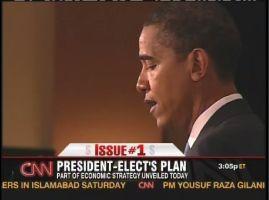President-elect Barack Obama this morning announced the broad architecture of his economic-recovery plan (see the weekly address video here).
As the New York Times reports, the centerpiece of the plan is a massive investment in public works, similar to FDR's economic-recovery plan in the 1930s:
President-elect Barack Obama committed Saturday to the largest public works construction program since the creation of the interstate highway system a half-century ago as he seeks to put together a plan to resuscitate the reeling economy.
With unemployment on the rise and no end to the recession in sight, Mr. Obama began highlighting elements of the economic recovery program he is trying to fashion with Congressional leaders in hopes of being able to enact it shortly after being sworn in on Jan. 20.
Mr. Obama’s remarks sought to expand the definition of traditional work programs for the middle class, like infrastructure projects to repair roads and bridges, while also pushing a federal effort to bring in new-era jobs in technology and so-called green jobs.
Although he put no price tag on it, he said he would invest record amounts of money in the vast infrastructure program, which also includes work on schools, sewer systems, mass transit, electric grids, dams and other public utilities. He vowed to upgrade computers in schools, expand broadband Internet access, make government buildings more energy efficient and improve information technology at hospitals and doctors’ offices.
The CNN report above discusses some of the political complications involved, particularly in the context of the national debate over the bailout for the Big Three automakers. But as Russ Wellen notes, the plan includes such features as an attention to broadband access, which demonstrate the Obama does appear to be keeping his eye on the ball.
All this suggests that perhaps Obama is heeding Paul Krugman's advice:
The economic lesson is the importance of doing enough. F.D.R. thought he was being prudent by reining in his spending plans; in reality, he was taking big risks with the economy and with his legacy. My advice to the Obama people is to figure out how much help they think the economy needs, then add 50 percent. It’s much better, in a depressed economy, to err on the side of too much stimulus than on the side of too little.
In short, Mr. Obama’s chances of leading a new New Deal depend largely on whether his short-run economic plans are sufficiently bold. Progressives can only hope that he has the necessary audacity.
As Steve Benen says, "January can't come soon enough."















